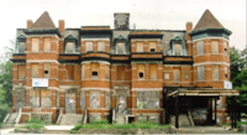Walking late at night, would you cross 14th Street to avoid passing this desolate row? And would four lanes of asphalt be enough insulation if you knew that 10,000 Washingtonians had started their final journey from its stoop?
In 1969, the route of the 50 bus had a new last name---“the-14th- Street- riot-corridor”. Perhaps it’s just a rumor that newer models were automatically assigned to more affluent lines, but the 50 buses were invariably wheezy and geriatric. As we left the flatlands with the Peoples Drug at the corner of U Street, the driver would try to build speed and the bus would labor forward strain forward like an arthritic horse straining to canter. At W Street, the transmission would whine like an electric drill boring concrete and rattle the windows in their frames as the driver assaulted the Fall Line slope in low gear. On the way up, there was always time to study the streetscape in detail.
Even after the riot, the east side of 14th Street was still a faceless string of vacant storefronts, used car lots, and gas stations. But above Belmont Street, the west side of the street was bounded by vast vacant lots, outlined by thick closely-spaced wooden posts driven into ground like dock pilings. In the summer heat, the lots were barren tan clay with the texture of unfinished concrete. But with spring rains they grew weeds in scattered tufts like a cheek shaved with a dull blade, and their low spots became orange puddles from the leached dust of a billion crushed bricks. The lots, with their backdrop of boarded-up and fire-scared buildings, were riot souvenirs until the mid-1970s.
The ridge that runs like an eyebrow above Florida Avenue has always inspired medieval fantasies. Although the 14th Street hill had nothing as elegant as 16th Street’s faux castle battlement it had a gothic abbey at the southwest corner of Chapin Street. Built of dark stone like the Heurich House, this 1870s mansion had a lowslung extension along 14th Street whose sky blue curtains were blowing to tatters behind broken windows. In 1969, the subtraction of more ordinary neighbors made some ruins seem so grand that no one would dare tear them down, although in time they did. One was the ivory-colored shell of Victoria Towers one of the most elegant “french flats” in 1890s Washington, which stood at the crest of the hill behind a row of dead storefronts.
This orange-brick row at 2901-2907 14th Street NW was one of the few active spots on the 14th Street ridge in the 1960s-70s. Until the late 1980s, it was flanked by rows of cars as the headquarters of the United Planning Organization, which coordinates the efforts of social service agencies in the District. It was built in the 1880s as a type of housing that never caught on along upper 14th Street, the luxury rowhouse.
By the late 1890s, when fashionable apartments like Victoria Towers, the Savoy Apartments, and the still-standing Olympia Flats were being erected on the 14th Street hill, its neighbors were storefronts with apartments above. But in 1900, the row still housed affluent families. At 2903, the 5 members of the family of real estate broker Charles Simpson were maintained by 2 servants. William Tucker, M.D. lived in the bay-fronted house at 2905, where his widowed mother was assisted by 3 servants in tending to 6 boarders, including an architect and an accountant and 4 government clerks. At 2907, David Wolhaumper, M.D. and his large multi-generational family roughed it with no live-in help at all.
From the turn of the 20th century, Stephen Hines both lived in and ran his funeral home from 2901, the turreted house on the northeastern corner of Harvard Street. But by 1920 the entire row, which sweeps around the corner into the 1300 block of Harvard, housed members of the Hines family and employees, including a husband and wife embalming team. During its 60 years on 14th Street the S.H. Hines home buried thousands of upper-middle and middle class Washingtonians, including Bernard Baruch's mother and such one-time notables Joe Turner, world champion "matman", wrestling impresario, philanthropist, and rough-hewn Duke Zeibert protype whose Kit-Mar Restaurant and Arena stood near the foot of the hill.
Today the future of the Hines row is murky, even as the Columbia Heights area undergoes a spectacular revival. Determining the plans for the property, presently in the hands of the DC Redevelopment Land Agency, frustrated Councilman Jim Graham, who in 2000 raised the possibility that the building might "fall in on itself " before it would be redeveloped (see http://www.innercity.org/tivoligiant/77.htm). The DC RLA website currently says that the Hines site is awaiting an "exclusive use agreement". In the meantime, the Greater Washington Urban League reports that it will be moving into the Hines buildings (see http://www.gwul.org/).
Hopefully some way can be found to preserve the Hines row before Councilman Graham’s prophecy comes to pass.
